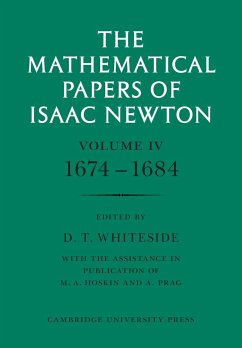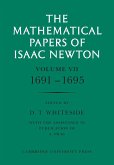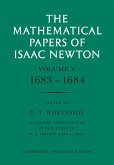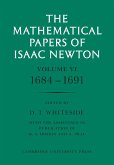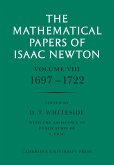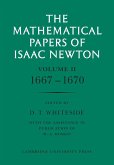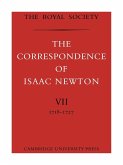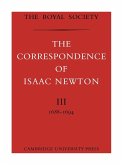- Broschiertes Buch
- Merkliste
- Auf die Merkliste
- Bewerten Bewerten
- Teilen
- Produkt teilen
- Produkterinnerung
- Produkterinnerung
This volume reproduces the texts of a number of important, yet relatively minor papers.
Andere Kunden interessierten sich auch für
![The Mathematical Papers of Isaac Newton The Mathematical Papers of Isaac Newton]() Isaac NewtonThe Mathematical Papers of Isaac Newton69,99 €
Isaac NewtonThe Mathematical Papers of Isaac Newton69,99 €![The Mathematical Papers of Isaac Newton The Mathematical Papers of Isaac Newton]() Isaac NewtonThe Mathematical Papers of Isaac Newton68,99 €
Isaac NewtonThe Mathematical Papers of Isaac Newton68,99 €![The Mathematical Papers of Isaac Newton The Mathematical Papers of Isaac Newton]() Isaac NewtonThe Mathematical Papers of Isaac Newton67,99 €
Isaac NewtonThe Mathematical Papers of Isaac Newton67,99 €![The Mathematical Papers of Isaac Newton The Mathematical Papers of Isaac Newton]() Isaac NewtonThe Mathematical Papers of Isaac Newton69,99 €
Isaac NewtonThe Mathematical Papers of Isaac Newton69,99 €![The Mathematical Papers of Isaac Newton The Mathematical Papers of Isaac Newton]() Isaac NewtonThe Mathematical Papers of Isaac Newton63,99 €
Isaac NewtonThe Mathematical Papers of Isaac Newton63,99 €![The Correspondence of Isaac Newton The Correspondence of Isaac Newton]() Isaac NewtonThe Correspondence of Isaac Newton105,99 €
Isaac NewtonThe Correspondence of Isaac Newton105,99 €![The Correspondence of Isaac Newton The Correspondence of Isaac Newton]() Isaac NewtonThe Correspondence of Isaac Newton104,99 €
Isaac NewtonThe Correspondence of Isaac Newton104,99 €-
-
-
This volume reproduces the texts of a number of important, yet relatively minor papers.
Hinweis: Dieser Artikel kann nur an eine deutsche Lieferadresse ausgeliefert werden.
Hinweis: Dieser Artikel kann nur an eine deutsche Lieferadresse ausgeliefert werden.
Produktdetails
- Produktdetails
- Verlag: Cambridge University Press
- Seitenzahl: 722
- Erscheinungstermin: 29. September 2007
- Englisch
- Abmessung: 244mm x 170mm x 38mm
- Gewicht: 1223g
- ISBN-13: 9780521045834
- ISBN-10: 0521045835
- Artikelnr.: 23438634
- Herstellerkennzeichnung
- Libri GmbH
- Europaallee 1
- 36244 Bad Hersfeld
- gpsr@libri.de
- Verlag: Cambridge University Press
- Seitenzahl: 722
- Erscheinungstermin: 29. September 2007
- Englisch
- Abmessung: 244mm x 170mm x 38mm
- Gewicht: 1223g
- ISBN-13: 9780521045834
- ISBN-10: 0521045835
- Artikelnr.: 23438634
- Herstellerkennzeichnung
- Libri GmbH
- Europaallee 1
- 36244 Bad Hersfeld
- gpsr@libri.de
Sir Isaac Newton (25 December 1642 - 20 March 1726/27) was an English mathematician, physicist, astronomer, theologian, and author (described in his own day as a "natural philosopher") who is widely recognised as one of the most influential scientists of all time and as a key figure in the scientific revolution. His book Philosophiæ Naturalis Principia Mathematica (Mathematical Principles of Natural Philosophy), first published in 1687, laid the foundations of classical mechanics. Newton also made seminal contributions to optics, and shares credit with Gottfried Wilhelm Leibniz for developing the infinitesimal calculus. In Principia, Newton formulated the laws of motion and universal gravitation that formed the dominant scientific viewpoint until it was superseded by the theory of relativity. Newton used his mathematical description of gravity to prove Kepler's laws of planetary motion, account for tides, the trajectories of comets, the precession of the equinoxes and other phenomena, eradicating doubt about the Solar System's heliocentricity. He demonstrated that the motion of objects on Earth and celestial bodies could be accounted for by the same principles. Newton's inference that the Earth is an oblate spheroid was later confirmed by the geodetic measurements of Maupertuis, La Condamine, and others, convincing most European scientists of the superiority of Newtonian mechanics over earlier systems.Newton built the first practical reflecting telescope and developed a sophisticated theory of colour based on the observation that a prism separates white light into the colours of the visible spectrum. His work on light was collected in his highly influential book Opticks, published in 1704. He also formulated an empirical law of cooling, made the first theoretical calculation of the speed of sound and introduced the notion of a Newtonian fluid. In addition to his work on calculus, as a mathematician Newton contributed to the study of power series, generalised the binomial theorem to non-integer exponents, developed a method for approximating the roots of a function, and classified most of the cubic plane curves. Newton was a fellow of Trinity College and the second Lucasian Professor of Mathematics at the University of Cambridge. He was a devout but unorthodox Christian who privately rejected the doctrine of the Trinity. Unusually for a member of the Cambridge faculty of the day, he refused to take holy orders in the Church of England. Beyond his work on the mathematical sciences, Newton dedicated much of his time to the study of alchemy and biblical chronology, but most of his work in those areas remained unpublished until long after his death. Politically and personally tied to the Whig party, Newton served two brief terms as Member of Parliament for the University of Cambridge, in 1689-90 and 1701-02. He was knighted by Queen Anne in 1705 and spent the last three decades of his life in London, serving as Warden (1696-1700) and Master (1700-1727) of the Royal Mint, as well as president of the Royal Society (1703-1727).
Part I. Researches in Algebra, Number Theory and Trigonometry: 1. Approaches to a General Theory of Finite Differences
2. Problems in Elementary Number Theory
3. Codifications of Elementary Plane and Spherical Trigonometry
4. Miscellaneous Notes on Annuities and Algebraic Factorization
Part II. Researches in Pure and Analytical Geometry: 1. Miscellaneous Problems in Elementary Geometry
2. Researches into the Greek 'Solid Locus'
3. Miscellaneous Topics in Analytical Geometry
Part III. The 'Geometria Curvilinea' and 'Matheseos Universalis Specimina': 1. The 'Geometry of Curved Lines'
2. Specimens of a Universal System of Mathematics
Appendix.
2. Problems in Elementary Number Theory
3. Codifications of Elementary Plane and Spherical Trigonometry
4. Miscellaneous Notes on Annuities and Algebraic Factorization
Part II. Researches in Pure and Analytical Geometry: 1. Miscellaneous Problems in Elementary Geometry
2. Researches into the Greek 'Solid Locus'
3. Miscellaneous Topics in Analytical Geometry
Part III. The 'Geometria Curvilinea' and 'Matheseos Universalis Specimina': 1. The 'Geometry of Curved Lines'
2. Specimens of a Universal System of Mathematics
Appendix.
Part I. Researches in Algebra, Number Theory and Trigonometry: 1. Approaches to a General Theory of Finite Differences
2. Problems in Elementary Number Theory
3. Codifications of Elementary Plane and Spherical Trigonometry
4. Miscellaneous Notes on Annuities and Algebraic Factorization
Part II. Researches in Pure and Analytical Geometry: 1. Miscellaneous Problems in Elementary Geometry
2. Researches into the Greek 'Solid Locus'
3. Miscellaneous Topics in Analytical Geometry
Part III. The 'Geometria Curvilinea' and 'Matheseos Universalis Specimina': 1. The 'Geometry of Curved Lines'
2. Specimens of a Universal System of Mathematics
Appendix.
2. Problems in Elementary Number Theory
3. Codifications of Elementary Plane and Spherical Trigonometry
4. Miscellaneous Notes on Annuities and Algebraic Factorization
Part II. Researches in Pure and Analytical Geometry: 1. Miscellaneous Problems in Elementary Geometry
2. Researches into the Greek 'Solid Locus'
3. Miscellaneous Topics in Analytical Geometry
Part III. The 'Geometria Curvilinea' and 'Matheseos Universalis Specimina': 1. The 'Geometry of Curved Lines'
2. Specimens of a Universal System of Mathematics
Appendix.

